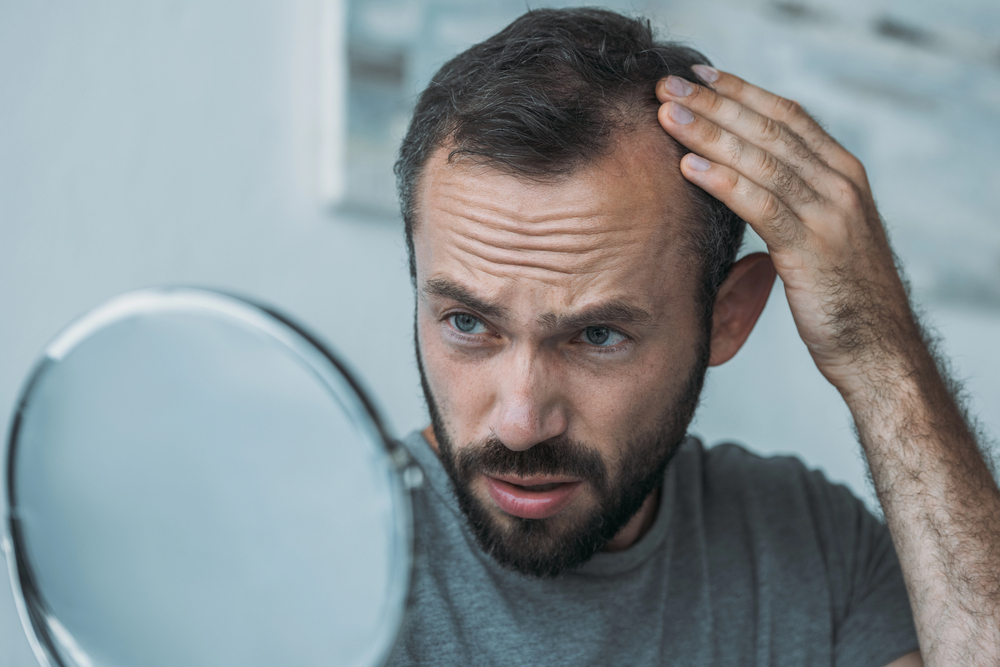Finasteride vs Dutasteride: Which Is Best?

Content by

Last Updated
Start a Consultation Today
Science means that hair loss can be optional...
No fancy packaging. No unwanted subscriptions. Delivered discreetly.
Androgenetic alopecia (male or female pattern baldness) is a common concern that can affect up to 50% of men and women worldwide. [1] Hair loss has a significant impact on self-esteem and confidence. Luckily, there are medications available to help with hair regrowth.
When patients suffer from androgenetic alopecia, they are generally prescribed Finasteride or Dutasteride by their healthcare provider. While both medications are very similar, there are some slight differences which make one more suitable for certain individuals than the other.
In this blog, we discuss those differences to determine whether Finasteride or Dutasteride is the best hair loss treatment.
Table of Contents
- What is the Difference Between Finasteride and Dutasteride?
- Are Finasteride and Dutasteride Suitable for Men and Women?
- Do Finasteride and Dutasteride Have the Same Dosage?
- Which is More Expensive?
- Do Finasteride and Dutasteride Have the Same Side Effects?
- Which is More Effective?
- Should I Take Finasteride or Dutasteride?
What is the Difference Between Finasteride and Dutasteride?
Finasteride and Dutasteride are part of a class of medication called 5-alpha reductase inhibitors. Both medications work by blocking the enzyme, 5-alpha-reductase, which is responsible for converting testosterone into dihydrotestosterone (DHT). Research shows high levels of DHT are responsible for hair loss. By reducing the level of DHT, it prevents hair loss and improves hair growth.
However, Dutasteride is more potent and has a broader range of action compared to Finasteride. Dutasteride blocks both type I and type II isoenzymes of 5-alpha reductase, while Finasteride only blocks the type II isoenzyme. This means that Dutasteride can further reduce DHT levels in the male body than Finasteride. [2]
Finasteride is FDA-approved and UK-licensed for the treatment of male pattern baldness, while Dutasteride is not approved yet, but it may be prescribed by doctors as an off-label drug.
Are Finasteride and Dutasteride Suitable for Men and Women?
Both Finasteride and Dutasteride are typically used to treat androgenetic alopecia in men. Therefore, these medications may not be suitable for use by women, especially women who are pregnant, may become pregnant or are breastfeeding. It may be prescribed to women in rare cases.
Finasteride and Dutasteride work by reducing the amount of DHT in the body. As the female body produces lower levels of testosterone and DHT, these medications may not deliver the same results as in men and could cause birth defects in male fetuses. [3,4]
Do Finasteride and Dutasteride Have the Same Dosage?
Finasteride and Dutasteride are only available with a prescription and come as oral tablets. Yet, their dosage is slightly different. Finasteride is usually sold under the Propecia brand with the recommended dosage of 1mg tablet once a day.
On the other hand, Dutasteride is often sold under the Avocart brand with a lower dosage of 0.5mg tablet daily. Dutasteride has a lower dosage than Finasteride because it is a more potent medication and requires a smaller amount of the active ingredient to achieve results.
Which is More Expensive?
In terms of cost, Dutasteride is typically more expensive than Finasteride, depending on the manufacturer and seller. Branded medication generally costs more than non-branded medication due to further research, development, testing and marketing.
High-street pharmacies in the UK charge an estimate between £11 and £55 for a 28-tablet box of Finasteride 1mg. At Chemist Click, a 28-tablet box of Finasteride 1mg starts from £13.89. In contrast, a 30-tablet box of Dutasteride can have a cost estimate between £15 and £45.
For larger quantities, prices can vary. A 168-tablet box of Finasteride 1mg ranges from £50 to £245, whereas a 120-tablet box of Dutasteride can cost between £64 to £104.
Do Finasteride and Dutasteride Have the Same Side Effects?
Due to the nature of both medications, Finasteride and Dutasteride have very similar side effects including:
- Decreased sex drive
- Erectile dysfunction
- Depression
- Breast tenderness or enlargement
There may be differences in the frequency and severity of these side effects between Finasteride and Dutasteride.
Which is More Effective?
A few studies have compared the efficacy of Finasteride and Dutasteride in treating male androgenetic alopecia.
In one study, 90 men with androgenetic alopecia between the ages of 18 and 40 years were randomised to receive Dutasteride 0.5 mg or Finasteride 1 mg daily. After 24 weeks of treatment, the study found that the increase in hair count and the decrease in thin hair count were significantly higher in the Dutasteride group than in the Finasteride group. As a result, Dutasteride was shown to be more effective than Finasteride in treating male androgenetic alopecia. [5]
The reason why Dutasteride is thought to be more effective than Finasteride may be due to its ability to inhibit both type I and type II isoenzymes of 5-alpha reductase, leading to a greater effect in reducing hair loss and promoting hair growth.
Should I Take Finasteride or Dutasteride?
Both Finasteride and Dutasteride have shown effective results with accurate use. Since it is FDA-approved and UK-licensed, Finasteride is usually the first-line treatment for male androgenetic alopecia. However, if you have tried Finasteride and have not seen any improvement after 6 months to a year, it might be worth switching to Dutasteride. It is not recommended to take Finasteride and Dutasteride together.
Before taking Finasteride or Dutasteride, it is essential to speak with your healthcare provider to determine the right medication for your hair loss condition regarding your medical history, underlying causes and other specific needs. Some patients may also be allergic or unable to tolerate Finasteride or Dutasteride. In this case, patients can look into alternative treatments such as Minoxidil.
Sources
- National Library of Medicine (2024). Androgenetic Alopecia. Retrieved on 15th August 2024, from: https://www.ncbi.nlm.nih.gov/books/NBK430924/
- National Library of Medicine (2017). Dutasteride in Androgenetic Alopecia: An Update. Retrieved on 15th August 2024, from: https://pubmed.ncbi.nlm.nih.gov/28294070/
- Mayo Clinic. (2024). Dutasteride (Oral Route). Retrieved on 15th August 2024, from: https://www.mayoclinic.org/drugs-supplements/dutasteride-oral-route/side-effects/drg-20063575?p=1
- Mayo Clinic. (2024). Finasteride (Oral Route). Retrieved on 15th August 2024, from: https://www.mayoclinic.org/drugs./finasteride./drg-20063819?p=1#:~:text=It%20may%20be%20used%20alone,called%205%2Dalpha%2Dreductase
- National Library of Medicine. (2017). Superiority of Dutasteride over Finasteride in hair regrowth and reversal of miniaturization in men with androgenetic alopecia: A randomized controlled open-label, evaluator-blinded study. Retrieved on 15th August 2024, from: https://pubmed.ncbi.nlm.nih.gov/27549867/
Whilst all of our content is written and reviewed by healthcare professionals, it is not intended to be substituted for or used as medical advice. If you have any questions or concerns about your health, please speak to your doctor.
